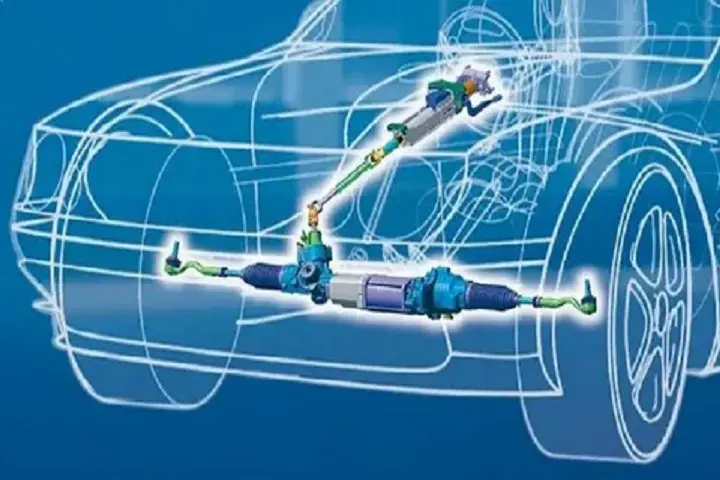Power steering fluid plays a crucial role in your vehicle’s steering system, Engine and Spot Signs yet it’s often overlooked in routine car maintenance.
This comprehensive guide will walk you through everything you need to know about power steering fluid, from its function to how to add it and spot potential leaks.
Whether you’re a seasoned DIY mechanic or a curious car owner, Engine and Spot Signs this article will empower you to keep your steering system in top shape.
The Unsung Hero of Your Steering Wheel
What is Power Steering Fluid?
Power steering fluid is a hydraulic fluid that’s essential for the proper functioning of your vehicle’s power assisted steering (PAS) system. This liquid gold enables you to turn your steering wheel with ease, especially when your car is stationary or moving at low speeds.
Why It’s Crucial for Your Vehicle’s Performance
Power steering fluid is the lifeblood of your steering system. It:
- Reduces the effort required to turn the steering wheel
- Protects internal components from wear and corrosion
- Transfers power from the steering pump to the steering gear
- Acts as a lubricant for moving parts
Without proper levels of this vital fluid, your car’s steering can become stiff, noisy, and potentially dangerous to operate.
The Magic Behind the Wheel: How Power Steering Fluid Works
Hydraulic Pressure and Its Role
The power steering system uses hydraulic pressure to assist in turning the wheels. Here’s a simplified breakdown of how it works:
- The power steering pump, driven by the engine, pressurizes the fluid.
- When you turn the steering wheel, valves open to direct the pressurized fluid.
- The fluid pushes against a piston in the steering gear or rack.
- This hydraulic force reduces the effort needed to turn the wheels.
Lubricating and Protecting Steering Components
Beyond its hydraulic function, power steering fluid also serves as a lubricant. It coats the internal components of the steering system, reducing friction and preventing premature wear. This lubrication is crucial for parts like the rack-mounted piston, seals and gaskets.
Heat Dissipation in the System
As the power steering system operates, it generates heat. The fluid absorbs this heat and carries it away from critical components, preventing overheating and potential damage.
Red Flags: Spotting Power Steering Fluid Issues
Recognizing the signs of power steering fluid problems can save you from costly repairs down the road. Here are some key indicators to watch out for: Engine and Spot Signs
Unusual Noises While Turning
- Whining or squealing: Often indicates low fluid levels or air in the system.
- Groaning or moaning: Could signal contaminated fluid or wear in the pump.
Steering Wheel Resistance or Stiffness
If your steering wheel feels heavier than usual, especially at low speeds, it might be due to:
- Low fluid levels
- A failing power steering pump
- Leaks in the system
Visible Leaks and Their Telltale Signs: Engine and Spot Signs
Power steering fluid leaks can appear in various locations:
| Leak Location | Appearance | Possible Cause |
| Under the car | Puddles or drops | Damaged hoses or seals |
| Near the wheels | Wet or oily spots | Rack and pinion issues |
| Around the pump | Oily residue | Failing pump seals |
Pro tip: Place cardboard under your parked car overnight to spot leaks easily.
Dashboard Warning Lights
Many modern vehicles have warning lights specifically for the power steering system. If you see a steering wheel icon or “EPS” (Electric Power Steering) light, it’s time for a checkup.
The Million-Dollar Question: Can I Drive Without Power Steering Fluid?
While it’s technically possible to drive without power steering fluid, it’s not recommended. Here’s why: Engine and Spot Signs
Short-term vs. Long-term Consequences
Short-term:
- Extremely difficult steering, especially at low speeds
- Risk of losing control in emergency situations
Long-term:
- Accelerated wear on steering components
- Potential for complete system failure
Potential Damage to Steering Components
Driving without adequate power steering fluid can lead to: Engine and Spot Signs
- Pump damage due to overheating and lack of lubrication
- Wear on seals and gaskets
- Corrosion of internal metal components
Safety Concerns on the Road
Low or no power steering fluid significantly impacts your ability to control your vehicle, especially in tight spaces or during emergency maneuvers. It’s not worth the risk to your safety and that of others on the road.
DIY Guide: Adding Power Steering Fluid to Your Engine
Topping up your power steering fluid is a simple task that can make a big difference in your car’s performance. Here’s how to do it:
Tools and Materials You’ll Need
- Power steering fluid (check your car’s owner manual for the recommended type)
- Funnel
- Clean cloth or paper towels
- Gloves (optional but recommended)
Step-by-Step Instructions
1. Locating the Reservoir
The power steering fluid reservoir is typically located near the engine, often on the passenger side. It’s usually a small, translucent container with markings for fluid levels: Engine and Spot Signs
2. Checking Current Fluid Levels
- Ensure the engine is off and cool.
- Wipe the dipstick or reservoir cap clean.
- Check the fluid level against the markings on the dipstick or reservoir.
3. Choosing the Right Fluid for Your Vehicle
Caution: Using the wrong type of fluid can cause serious damage to your power steering system.
- Check your car’s owner manual for the recommended fluid type.
- Common types include:
- Prestone Power Steering Fluid
- ATF (Automatic Transmission Fluid)
- Synthetic power steering fluid
4. Proper Filling Technique
- Remove the reservoir cap.
- Insert a clean funnel into the opening.
- Slowly add fluid until it reaches the “Full” line.
- Avoid overfilling, as this can lead to leaks or damage.
5. Post-Fill Checks and Precautions
- Replace the cap securely.
- Start the engine and turn the steering wheel lock-to-lock several times.
- Recheck the fluid level and top up if necessary.
- Inspect for leaks around the reservoir and steering components.
Sherlock Holmes of the Garage: Detecting Power Steering Fluid Leaks

Identifying the source of a power steering fluid leak can save you time and money. Here’s how to play detective:
Common Leak Locations
- Power steering pump: Look for wet spots or drips around the pump.
- Hoses and connections: Check for cracks, splits, or loose fittings.
- Rack and pinion seals: Inspect the area around your front wheels for signs of fluid.
- Steering gear box: On older vehicles, look for leaks near the steering column.
DIY Inspection Techniques
- Visual inspection: Look for wet spots, drips, or accumulated grime under the car.
- UV dye method:
- Add UV dye to your power steering fluid.
- Run the engine and turn the steering wheel.
- Use a UV light to spot the fluorescent dye at the leak point.
- Pressure test: A professional can perform this test to locate hard-to-find leaks.
When to Seek Professional Help
While many leaks can be spotted and even fixed at home, some situations call for expert assistance:
- Internal leaks in the rack and pinion or steering gear
- Persistent leaks after DIY repairs
- When you’re unsure about the source or severity of the leak
Remember, addressing leaks promptly can prevent more serious and costly repairs down the road.
Preventive Maintenance: Keeping Your Power Steering System Happy
An ounce of prevention is worth a pound of cure, especially when it comes to your car’s steering system. Here’s how to keep it in top shape:
Regular Fluid Checks and Top-Ups
- Check your power steering fluid level at least once a month.
- Top up as needed, but be cautious of frequent top-ups, which may indicate a leak.
Flushing the System: When and Why
Power steering fluid can degrade over time, losing its effectiveness. Flushing the system:
- Removes contaminants and metal particles
- Helps prevent corrosion and wear
- Extends the life of steering components
Recommended frequency: Every 50,000 miles or as specified in your owner’s manual.
Other Components to Monitor
- Power steering belt: Check for cracks, fraying, or glazing.
- Hoses: Inspect for bulges, cracks, or leaks.
- Pump pulley: Ensure it’s properly aligned and not wobbling.
Environmental Considerations
As responsible car owners, we must consider the environmental impact of our maintenance practices.
Proper Disposal of Old Power Steering Fluid
Power steering fluid is toxic and should never be poured down drains or onto the ground. Instead:
- Collect old fluid in a sealed container.
- Take it to an authorized recycling center or auto parts store.
- Many places offer free fluid disposal services.
Eco-Friendly Alternatives on the Horizon
The automotive industry is exploring greener options for power steering systems:
- Electric power steering: Uses an electric motor instead of hydraulic fluid.
- Biodegradable fluids: Made from renewable resources and easier on the environment.
- Synthetic fluids: Often last longer and require less frequent changes.
FAQ: Engine and Spot Signs
How often should I change my power steering fluid?
Most manufacturers recommend changing power steering fluid every 50,000 to 100,000 miles. However, check your owner’s manual for specific recommendations.
Can I mix different types of power steering fluid?
It’s not recommended to mix different types of power steering fluid. Doing so can cause chemical reactions that degrade the fluid’s performance or damage seals.
What’s the difference between power steering fluid and transmission fluid?
While some vehicles use ATF (Automatic Transmission Fluid) for power steering, they are generally different:
- Power steering fluid is specifically designed for hydraulic steering systems.
- Transmission fluid is formulated for the unique needs of automatic transmissions.
Is power steering fluid flammable?
Yes, power steering fluid is flammable. Keep it away from heat sources and open flames.
Can low power steering fluid cause check engine light?
Typically, low power steering fluid won’t trigger the check engine light. However, it may activate a power steering warning light if your vehicle is equipped with one.
Conclusion: Empowering Your Driving Experience
Understanding and maintaining your vehicle’s power steering system is crucial for safe and enjoyable driving. By keeping an eye on your power steering fluid levels, addressing leaks promptly, and performing regular maintenance, you can ensure smooth steering and prevent costly repairs.
Remember:
- Check your power steering fluid regularly
- Use the correct type of fluid for your vehicle
- Address any unusual noises or steering difficulties promptly
- Consider the environmental impact of your maintenance practices
By following these guidelines, you’ll not only enhance your driving experience but also contribute to the longevity of your vehicle’s steering system. Happy driving, and may your turns always be smooth!

With over 5 years of dedicated experience in the automotive industry, I am passionate about all things automotive. My journey began with a deep curiosity for automobiles, which led me to delve deeper into their mechanics, technology and trends. My expertise spans various aspects of the automotive world, from the latest electric vehicles to classic car restoration techniques. Through my articles, I aim to share my knowledge and insights, helping readers stay informed and inspired in the fast-paced world of the automobile.












